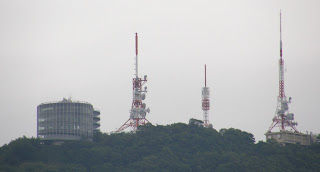2.
Walked
along the harbor and through Seaside Park to find the Glover Gardens. This part of Nagasaki was the area in which
most Westerners lived in the late 18th and 19th centuries
so the gardens contain a number of homes and other buildings from that era. On the way to Glover Gardens I passed Oura
Catholic Church, built in 1864 by a French priest; it is Japan’s oldest
remaining gothic-style wooden church.
After climbing up some more, I reached the
Glover Gardens entrance – and more stairs!
Fortunately the Japanese do believe in mechanical aids so there were
also escalators and moving sidewalks for some of the worst hills within the
Gardens. There was a major effort to
make the Gardens area handicapped accessible.
Given
the dates of the buildings and no information talking about major
reconstruction, it appears that this part of the city must have escaped major
damage by the atomic bomb. Nagasaki is the setting for the opera Madame
Butterfly and there is a lot of pride in that fact as evidenced by these
statues of Giacomo Puccini, composer, and Tamaki Miura, opera singer who was
famous for her role as Madame Butterfly.
7.
The
Ringer House and Glover House are examples of the 19th century
western homes. The Glover House is the
oldest western-style wood building in Japan, built in 1863. Inside there are some artifacts from the
Glover family. The gardens were lovely,
and there was a large conservatory, outside which I’m standing in the picture
below. All rooms in the Glover House opened directly to the outside – great for
views and airiness, probably not so good for security!
The
gardens which surround the buildings are varied and lovely. The cycad tree is 300 years old, having been
presented to Thomas Glover by Lord Shimazu as an already-large plant when the
house was built. This particular rose
had a really lovely smell.
Leaving
the Glover Gardens I found myself at the Nagasaki Traditional Performing Arts
Museum. There was a large-screen video
showing the Nagasaki Festival and its dances while the props used in the
Festival were on display.
Walking back toward the hotel I saw a sign for Dutch Slope so headed in that direction. At the point I saw another sign, pointing up a fairly steep road, it began raining. I decided I wasn’t interested in climbing in the rain just to see a slope and more western-style homes. So returned to my hotel-bound journey. Met a young woman who looked Japanese who commented in English how difficult it was to find one’s way with signs only in Japanese. Of Japanese heritage, living in Brazil, she was in the country for a medical conference. Having some free time she made a one-day trip to Nagasaki and wanted to see the Dejima, which she understood was the start of western medicine in Japan. Knowing the Dejima was a block from my hotel, we walked together until she reached her destination and began taking some pictures. She speaks Portuguese, English, Spanish, and French, but, despite the encouragement of her Japanese-born parents, hasn't yet mastered Japanese.
Reached
the hotel and decided to spend the evening in.
The rain had stopped, but the weather wasn’t great. After two days of hard sightseeing I was
ready for relaxing a bit. Also, had to
pack since my flight to Osaka and on to Seoul leaves tomorrow.

















No comments:
Post a Comment